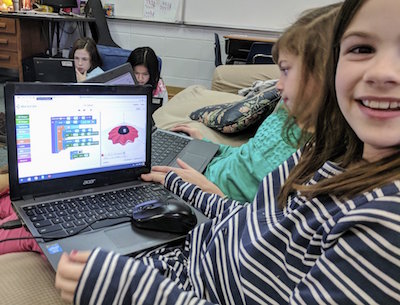2018 Finalist
BlocksCAD
Powering Education In Makerspaces
BlocksCAD is a web-based software design and modeling tool that reinforces coding, math, visualization, and design as students create models for 3D printing.

Tell us about your enterprise.
BlocksCAD was born out of a teaching necessity. Four and half years ago, myself and my co-founder, Jennie Yoder, were teaching a STEAM-focused after school program in the Greater Boston area when the program acquired a 3D printer. As we sought to integrate it into the program, we realized that there wasn’t software available that met the educational standards we were looking to achieve. My cofounder and some of our colleagues wrote our own software, the first version of BlocksCAD, to give our students a robust and engaging experience using the printer and incorporating design and 3D modeling into our class. We soon found that it was doing what we’d hoped: getting students as young as the third grade excited about designing and modeling.
It took about 2 years to fully develop the software. In the process of building out the software we discovered that there were teachers around the country and around the world who had the same problem. Makerspaces and 3D printers were going into schools but there was no real forethought about how teachers were going to teach with the technology or how it would integrate into existing academic requirements and standards.
What is your business model?
BlocksCAD’s web-based software program is free for anyone to use. What we charge for is the curriculum package. Educators subscribe to BlocksCAD for Education and receive standards-aligned curriculum and additional training scaffolding including videos, teacher manuals, lesson plans and alignment maps, as well as the infrastructure for organizing and managing students in the classroom.
Who is the target market?
BlocksCAD can address computer science education needs in districts requiring instruction in middle and elementary school. We built BlocksCAD Education around curriculum standards and a project management infrastructure so that schools and districts can provide resources for teachers to teach a wide range of subjects with BlocksCAD – including math standards for students in grades 3 and above.
How are schools and educators responding?
We focus our sales and marketing attention on district-level sales, though we also have teachers and schools that sign up for classroom or school-wide licenses. We currently have 4 district-wide subscribers and 35 classroom/school subscribers. We did a little over $50,000 in subscription business last year and are projecting around $350,000 for this year. Our actual paid student subscriber base is around 9,000 students. Our registered software user base is around 55,000 students now – 350% growth over last year.
How did you come to enter the EBPC?
We were encouraged to apply to the Milken Penn Education Business Plan Competition by colleagues at the LearnLaunch edtech accelerator program in Boston. We were thrilled to be a Finalist in 2018 in the EBPC.
What role has the EBPC played in your story?
The competition was a great opportunity to present BlocksCAD to a lot of incredible folks in education and in the edtech space. We had some terrific conversations and follow-ups with investors and other potential networking opportunities within the edtech community. Certainly, being named a finalist provides critical credibility and exposure. Our participation speaks well to our viability and validates the potential of BlocksCAD in the marketplace.
What is next for BlocksCAD?
Our focus on computer science and math education is the next phase for us. We are focusing on how BlocksCAD integrates into a richer computer science and math experience. We’ve also done some technical developments making BlocksCAD a tool for use with virtual reality technology, which is the next wave of education technology.
We are also looking at opportunities to validate our program’s efficacy as a learning tool. It’s difficult because there are currently no recognized computer science educational standards, but it’s something we can pursue within the math curriculum with a greater chance of measurability and acceptance.
What advice would you give to aspiring education entrepreneurs?
Make sure you are solving a real problem, that there is a real need and that the need is ultimately being supported by someone who has the capacity to pay for it. You can have fantastic outcomes and teachers that love you, but you can’t be successful if there is no budget.
To learn more, visit BlocksCAD3D.com